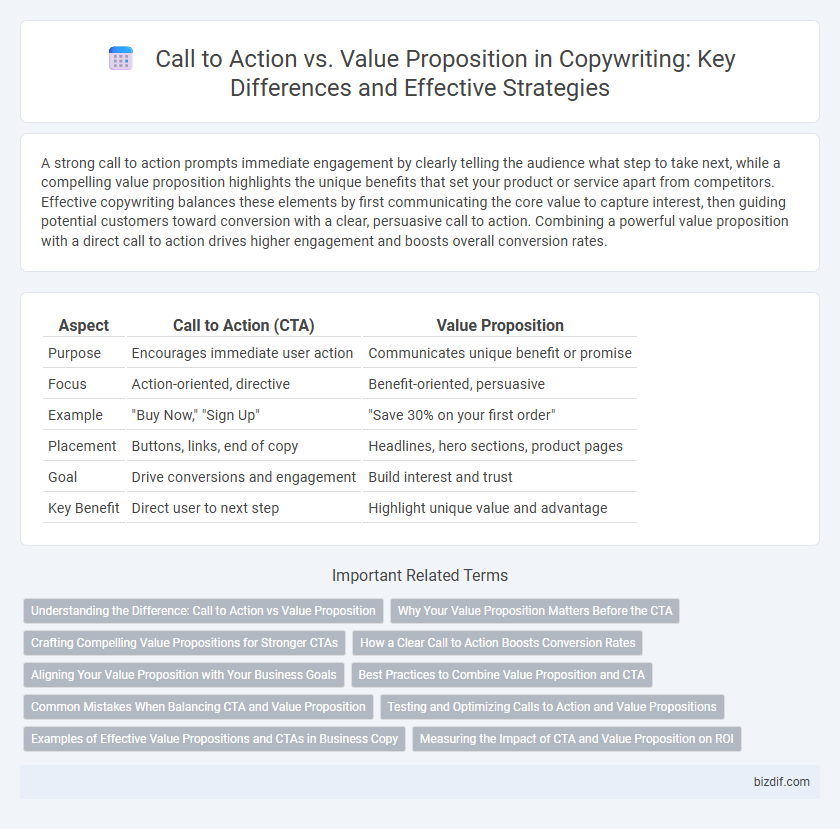A strong call to action prompts immediate engagement by clearly telling the audience what step to take next, while a compelling value proposition highlights the unique benefits that set your product or service apart from competitors. Effective copywriting balances these elements by first communicating the core value to capture interest, then guiding potential customers toward conversion with a clear, persuasive call to action. Combining a powerful value proposition with a direct call to action drives higher engagement and boosts overall conversion rates.
Table of Comparison
| Aspect | Call to Action (CTA) | Value Proposition |
|---|---|---|
| Purpose | Encourages immediate user action | Communicates unique benefit or promise |
| Focus | Action-oriented, directive | Benefit-oriented, persuasive |
| Example | "Buy Now," "Sign Up" | "Save 30% on your first order" |
| Placement | Buttons, links, end of copy | Headlines, hero sections, product pages |
| Goal | Drive conversions and engagement | Build interest and trust |
| Key Benefit | Direct user to next step | Highlight unique value and advantage |
Understanding the Difference: Call to Action vs Value Proposition
A Call to Action (CTA) directs customers to take a specific step, such as "Buy Now" or "Subscribe Today," emphasizing immediate engagement. In contrast, a Value Proposition defines the unique benefits and reasons why a product or service stands out, focusing on delivering long-term value and solving customer pain points. Understanding the difference between a CTA and a Value Proposition is crucial for effective copywriting that both attracts attention and drives conversions.
Why Your Value Proposition Matters Before the CTA
A clear value proposition communicates the unique benefits and solutions your product or service offers, establishing trust and relevance with your audience. This foundation motivates prospects by addressing their needs and pain points, making the subsequent call to action more compelling and effective. Without a strong value proposition, even the most persuasive CTA may fail to convert potential customers.
Crafting Compelling Value Propositions for Stronger CTAs
Crafting compelling value propositions highlights the unique benefits of a product or service, creating a strong foundation for effective call to action (CTA) buttons. A clear and concise value proposition captures audience attention and builds trust, increasing the likelihood of conversion when paired with a persuasive CTA. Integrating emotional triggers and specific outcomes in the value proposition amplifies the impact of CTAs, driving higher engagement and sales.
How a Clear Call to Action Boosts Conversion Rates
A clear call to action (CTA) directs users towards the desired action, significantly increasing conversion rates by reducing decision-making friction. Unlike a value proposition, which communicates the product's benefits and uniqueness, the CTA provides a specific instruction that motivates immediate engagement. Optimizing CTAs with concise language, contrasting colors, and strategic placement enhances user interaction and drives higher sales or sign-ups.
Aligning Your Value Proposition with Your Business Goals
Aligning your value proposition with your business goals ensures your call to action resonates deeply with your target audience, enhancing conversion rates and customer loyalty. A clear value proposition articulates the unique benefits your product or service offers, directly supporting strategic objectives such as market expansion or customer retention. Crafting calls to action that reflect this alignment drives focused user engagement and measurable business growth.
Best Practices to Combine Value Proposition and CTA
Strong copywriting integrates a clear value proposition with a compelling call to action to maximize conversion rates. Highlighting unique benefits and addressing customer pain points while using action-oriented language in the CTA boosts user engagement and drives sales. Testing different combinations of value propositions and CTAs can optimize effectiveness across diverse audience segments.
Common Mistakes When Balancing CTA and Value Proposition
Common mistakes when balancing Call to Action (CTA) and Value Proposition include overloading the message with excessive CTAs, which dilutes the main value offered and confuses users. Failing to clearly align the CTA with the core value proposition results in weakened user motivation and lower conversion rates. Ignoring the importance of concise, benefit-driven language in both elements undermines the overall persuasive impact of the copy.
Testing and Optimizing Calls to Action and Value Propositions
Testing and optimizing calls to action (CTAs) and value propositions involves A/B testing different messaging, designs, and placements to identify what drives higher conversion rates. Utilizing analytics tools to track user behavior and engagement metrics enables precise adjustments that enhance click-through and conversion performance. Continual iteration based on data insights ensures CTAs and value propositions resonate effectively with target audiences for maximum impact.
Examples of Effective Value Propositions and CTAs in Business Copy
Effective value propositions clearly communicate unique benefits, such as Slack's "Be More Productive at Work with Less Effort," which highlights simplicity and efficiency. Strong calls to action include phrases like "Start Your Free Trial Today" or "Get Your Personalized Quote Now," creating urgency and guiding customer behavior. Combining a compelling value proposition with a direct CTA increases conversions by aligning customer needs with immediate next steps.
Measuring the Impact of CTA and Value Proposition on ROI
Measuring the impact of Call to Action (CTA) and Value Proposition on ROI involves analyzing conversion rates, customer engagement metrics, and sales growth influenced by each element. Data-driven testing such as A/B experiments helps isolate the effectiveness of the CTA's urgency versus the Value Proposition's customer-centric benefits in driving user actions. Integrating analytics platforms to track these variables provides precise insights into how each component boosts overall return on investment.
Call to Action vs Value Proposition Infographic

 bizdif.com
bizdif.com